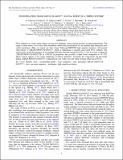Files in this item
Investigating 2MASS J06593158-0405277 : a FUor burst in a triple system?
Item metadata
| dc.contributor.author | Caratti o Garatti, A. | |
| dc.contributor.author | Garcia Lopez, R. | |
| dc.contributor.author | Ray, T. P. | |
| dc.contributor.author | Eislöffel, J. | |
| dc.contributor.author | Stecklum, B. | |
| dc.contributor.author | Scholz, A. | |
| dc.contributor.author | Kraus, S. | |
| dc.contributor.author | Weigelt, G. | |
| dc.contributor.author | Kreplin, A. | |
| dc.contributor.author | Shenavrin, V. | |
| dc.date.accessioned | 2016-04-13T15:30:03Z | |
| dc.date.available | 2016-04-13T15:30:03Z | |
| dc.date.issued | 2015-06-02 | |
| dc.identifier | 194132732 | |
| dc.identifier | 9fd7c9aa-790e-43b9-b9fa-a75275dc3450 | |
| dc.identifier | 84930942557 | |
| dc.identifier | 000356633700004 | |
| dc.identifier.citation | Caratti o Garatti , A , Garcia Lopez , R , Ray , T P , Eislöffel , J , Stecklum , B , Scholz , A , Kraus , S , Weigelt , G , Kreplin , A & Shenavrin , V 2015 , ' Investigating 2MASS J06593158-0405277 : a FUor burst in a triple system? ' , Astrophysical Journal Letters , vol. 806 , no. 1 , L4 . https://doi.org/10.1088/2041-8205/806/1/L4 | en |
| dc.identifier.issn | 2041-8205 | |
| dc.identifier.other | BibCode: 2015arXiv150503691G | |
| dc.identifier.other | BibCode: 2015ApJ...806L...4C | |
| dc.identifier.other | ArXiv: http://arxiv.org/abs/1505.03691v1 | |
| dc.identifier.uri | https://hdl.handle.net/10023/8610 | |
| dc.description | A.C.G., R.G.L., and T.P.R. were supported by Science Foundation Ireland, grant 13/ERC/I2907. S.K. acknowledges support from an STFC Ernest Rutherford Fellowship (ST/J004030/1), Ernest Rutherford Grant (ST/K003445/1), and Marie Curie CIG grant (SH-06192). | en |
| dc.description.abstract | FUor outbursts in young stellar objects (YSOs) are the most dramatic events among episodic accretion phenomena. The origin of these bursts is not clear: disk instabilities and/or disk perturbations by an external body being the most viable hypotheses. Here, we report our VLT/SINFONI high angular resolution AO-assisted observations of 2MASSJ06593158-0405277, which is undergoing a recently discovered FUoroutburst. Our observations reveal the presence of an extended disc-like structure around the FUor, a very low-mass companion (2MASSJ06593158-0405277B) at ~100 au in projection, and, possibly, a third closer companion at ~11 au. These sources appear to be young, displaying accretion signatures. Assuming the components are physically linked,2MASS J06593158-0405277 would then be one of the very few triple systems observed in FUors. | |
| dc.format.extent | 5 | |
| dc.format.extent | 798592 | |
| dc.language.iso | eng | |
| dc.relation.ispartof | Astrophysical Journal Letters | en |
| dc.subject | Binaries: close | en |
| dc.subject | Circumstellar matter | en |
| dc.subject | Stars: formation | en |
| dc.subject | Stars: individual: 2MASS J06593158-0405277 | en |
| dc.subject | Stars: pre-main sequence | en |
| dc.subject | Techniques: high angular resolution | en |
| dc.subject | QB Astronomy | en |
| dc.subject | QC Physics | en |
| dc.subject | NDAS | en |
| dc.subject.lcc | QB | en |
| dc.subject.lcc | QC | en |
| dc.title | Investigating 2MASS J06593158-0405277 : a FUor burst in a triple system? | en |
| dc.type | Journal article | en |
| dc.contributor.institution | University of St Andrews. School of Physics and Astronomy | en |
| dc.identifier.doi | https://doi.org/10.1088/2041-8205/806/1/L4 | |
| dc.description.status | Peer reviewed | en |
| dc.identifier.url | http://adsabs.harvard.edu/abs/2015arXiv150503691G | en |
This item appears in the following Collection(s)
Items in the St Andrews Research Repository are protected by copyright, with all rights reserved, unless otherwise indicated.

